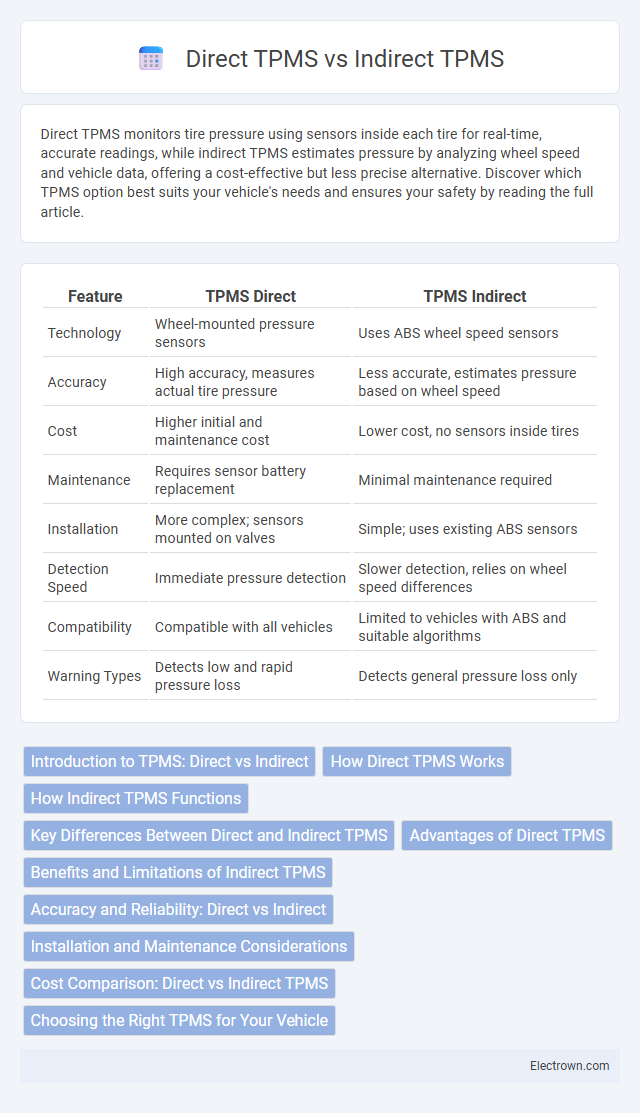Direct TPMS monitors tire pressure using sensors inside each tire for real-time, accurate readings, while indirect TPMS estimates pressure by analyzing wheel speed and vehicle data, offering a cost-effective but less precise alternative. Discover which TPMS option best suits your vehicle's needs and ensures your safety by reading the full article.
Table of Comparison
| Feature | TPMS Direct | TPMS Indirect |
|---|---|---|
| Technology | Wheel-mounted pressure sensors | Uses ABS wheel speed sensors |
| Accuracy | High accuracy, measures actual tire pressure | Less accurate, estimates pressure based on wheel speed |
| Cost | Higher initial and maintenance cost | Lower cost, no sensors inside tires |
| Maintenance | Requires sensor battery replacement | Minimal maintenance required |
| Installation | More complex; sensors mounted on valves | Simple; uses existing ABS sensors |
| Detection Speed | Immediate pressure detection | Slower detection, relies on wheel speed differences |
| Compatibility | Compatible with all vehicles | Limited to vehicles with ABS and suitable algorithms |
| Warning Types | Detects low and rapid pressure loss | Detects general pressure loss only |
Introduction to TPMS: Direct vs Indirect
TPMS direct systems utilize individual wheel sensors to monitor tire pressure in real-time, providing accurate and immediate alerts for low pressure conditions. TPMS indirect systems estimate tire pressure by analyzing wheel speed data from the ABS sensors, offering a cost-effective solution without the need for dedicated pressure sensors. Direct TPMS delivers precise pressure readings, while indirect TPMS relies on relative measurements and requires periodic recalibration after tire rotations.
How Direct TPMS Works
Direct TPMS uses sensors mounted on each tire valve or inside the tire to measure air pressure in real-time, transmitting data wirelessly to the vehicle's onboard computer. Each sensor includes a battery-powered pressure transducer that sends accurate tire pressure readings, enabling immediate alerts for under-inflation or leaks. This system provides precise pressure measurements for individual tires, enhancing safety and fuel efficiency by ensuring optimal tire conditions are maintained.
How Indirect TPMS Functions
Indirect TPMS functions by using the vehicle's ABS wheel speed sensors to monitor tire rotation rates, detecting differences indicative of low tire pressure. This system compares the rotational speed of each tire, as underinflated tires have smaller effective diameters and spin faster, triggering a warning when discrepancies exceed preset thresholds. You can benefit from this cost-effective method, though it requires periodic sensor recalibration and does not measure actual tire pressure directly.
Key Differences Between Direct and Indirect TPMS
Direct TPMS uses pressure sensors mounted inside each tire to provide real-time, precise tire pressure readings, enhancing accuracy and immediate alerting of tire pressure issues. Indirect TPMS relies on the vehicle's ABS or wheel speed sensors to monitor tire rotation differences, estimating pressure indirectly through changes in tire circumference. Direct TPMS offers detailed individual tire data and faster fault detection, while indirect TPMS is generally more cost-effective with simpler sensor maintenance but less precise pressure information.
Advantages of Direct TPMS
Direct TPMS provides accurate real-time tire pressure readings through sensors mounted inside each tire, enhancing safety by alerting you immediately to pressure drops. It helps maintain optimal fuel efficiency and tire lifespan by ensuring precise monitoring of all four tires individually. Compared to indirect TPMS, direct TPMS offers better reliability since it is unaffected by changing driving conditions or wheel rotations.
Benefits and Limitations of Indirect TPMS
Indirect TPMS offers benefits such as lower cost and easier installation since it utilizes existing ABS wheel speed sensors without the need for additional hardware. It effectively monitors tire pressure by detecting differences in wheel rotational speeds caused by underinflation, which helps maintain fuel efficiency and tire longevity. Limitations include reduced accuracy compared to direct TPMS and an inability to provide exact tire pressure readings, relying instead on relative pressure changes that may lead to delayed or less precise alerts.
Accuracy and Reliability: Direct vs Indirect
Direct TPMS uses sensors inside each tire to provide accurate and reliable real-time tire pressure readings, minimizing false alerts and ensuring precise monitoring. Indirect TPMS estimates pressure by analyzing wheel speed data from the ABS sensors, making it less accurate and prone to errors under certain conditions like tire wear or temperature changes. Your choice between direct and indirect systems impacts the consistency of tire pressure information essential for safety and fuel efficiency.
Installation and Maintenance Considerations
Direct TPMS requires sensors installed inside each tire, ensuring accurate pressure readings but involving higher initial installation costs and sensor battery replacements over time. Indirect TPMS uses existing ABS wheel speed sensors to estimate tire pressure without additional hardware, resulting in simpler installation and lower maintenance but less precise measurements. Maintenance for direct TPMS includes sensor recalibration and battery replacement, while indirect TPMS relies mainly on system resets after tire rotation or pressure adjustments.
Cost Comparison: Direct vs Indirect TPMS
Direct TPMS sensors, installed in each wheel, generally incur higher upfront costs due to sensor hardware and installation complexity, averaging around $50 to $100 per sensor. Indirect TPMS relies on existing ABS wheel speed sensors and software algorithms, resulting in lower installation and maintenance costs but potentially reduced accuracy. Vehicle owners aiming to balance expenses with reliability often find indirect TPMS more budget-friendly, while direct TPMS offers precise tire pressure readings at a premium cost.
Choosing the Right TPMS for Your Vehicle
When choosing the right TPMS for your vehicle, direct TPMS offers precise real-time tire pressure readings by using sensors inside each tire, providing accurate alerts for safety and efficiency. Indirect TPMS relies on wheel speed sensor data from the ABS system, making it a cost-effective option but less accurate than direct systems. Your choice depends on the vehicle's compatibility, desired accuracy, and maintenance preferences.
TPMS direct vs TPMS indirect Infographic

 electrown.com
electrown.com